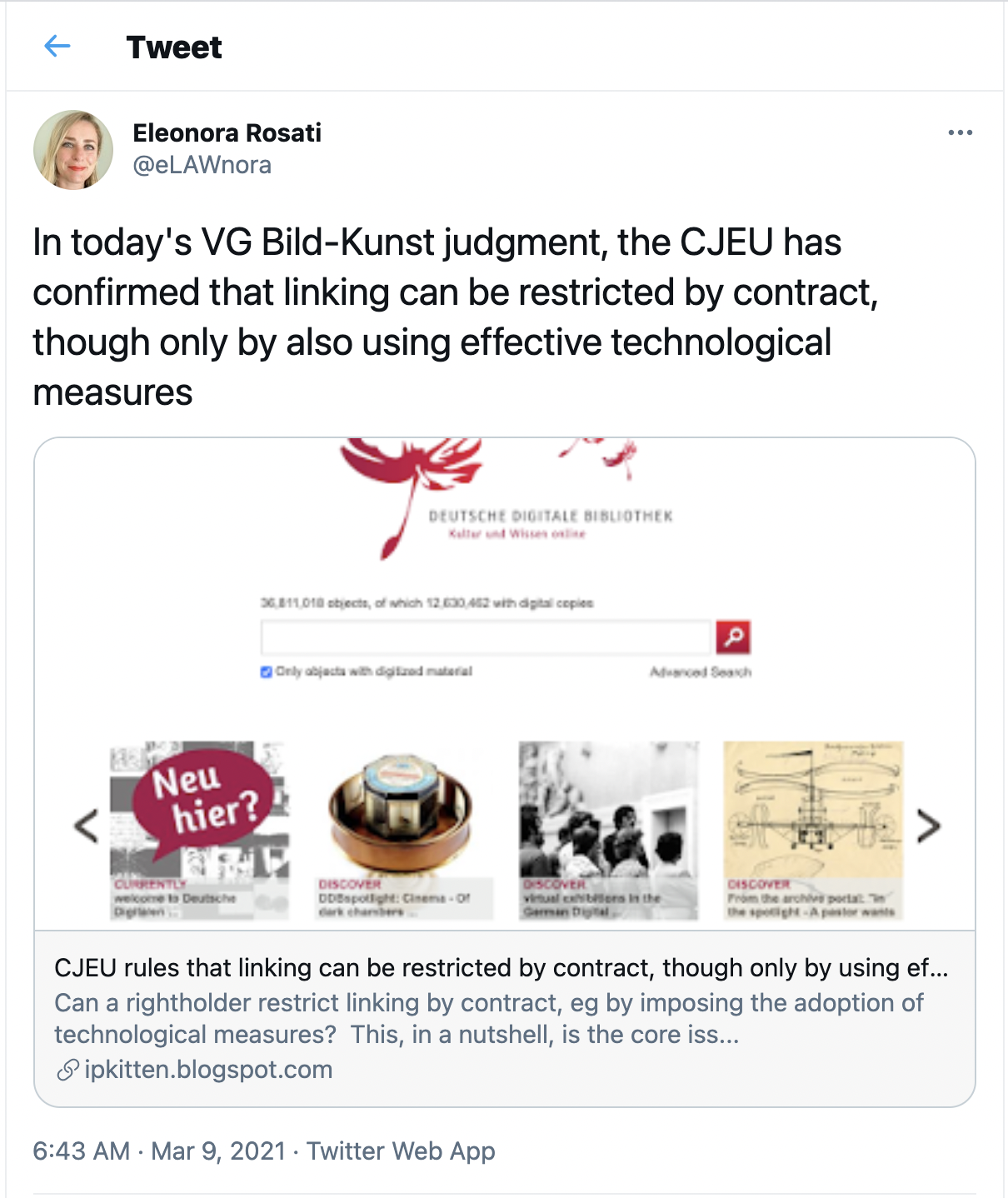“The decision is the Court’s latest ruling in the struggle to balance the interests of copyright owners with those of internet users.”
 Copyright holders can require licensees to implement technical measures to prevent infringement, the Court of Justice of the EU (CJEU) has ruled in its latest decision on the “right of communication to the public” in EU copyright law. (Case C-392/19 VG Bild-Kunst v. Stiftung Preußischer Kulturbesitz.)
Copyright holders can require licensees to implement technical measures to prevent infringement, the Court of Justice of the EU (CJEU) has ruled in its latest decision on the “right of communication to the public” in EU copyright law. (Case C-392/19 VG Bild-Kunst v. Stiftung Preußischer Kulturbesitz.)
The Court’s Grand Chamber, comprising 15 judges, gave its ruling on questions referred from Germany in a dispute between a copyright collecting society for visual art, VG Bild-Kunst, and Stiftung Preußischer Kulturbesitz (SPK), a cultural heritage foundation that operates a digital library called Deutsche Digitale Bibliothek. The digital library includes thumbnails of images and links to the institution providing the subject matter.
VG Bild-Kunst refused to license SPK to use its catalogue unless there was a provision requiring effective technological measures to prevent the framing, by third parties, of the copyright-protected works. The case addressed essentially whether it was entitled to impose such a condition.
In response to the question referred by the German Federal Court of Justice, the CJEU said that Article 3(1) of the 2001 InfoSoc Directive “must be interpreted as meaning that the embedding, by means of the technique of framing, in a third party website page, of works that are protected by copyright and that are freely accessible to the public with the authorisation of the copyright holder on another website, where that embedding circumvents measures adopted or imposed by that copyright holder to provide protection from framing, constitutes a communication to the public within the meaning of that provision.”
The Court’s Reasoning
The Court found that the technique of framing (consisting in dividing a web page into several frames and posting within one of them an element from another website) constitutes an “act of communication to a public” since its effect is to make the posted element available to all the potential users of that website. But provided the technical means used in framing are the same as those used on the original website (namely the Internet), that communication is not to “a new public” and the copyright holder’s authorization is not required.
However, it said that “communication to the public” must be interpreted based on the facts of each case, including whether the right holder has established or imposed “restrictive measures” linked to the publication of his or her work. If a clickable link makes it possible for users to circumvent such measures, those users must be deemed to be a new public.
The Court added that this case concerns a situation where the copyright holder is seeking to make the grant of a license subject to restrictive measures: “In such circumstances, that copyright holder cannot be regarded as having consented to third parties being able freely to communicate his or her works to the public.”
Therefore, the initial act of making available (on the original website) and the second act of making available (by framing) constitute different communications to the public, each of which must be authorized by the rights holder.
But the Court also said that “the copyright holder cannot be allowed to limit his or her consent by means other than effective technological measures.”
The decision is the Court’s latest ruling in the struggle to balance the interests of copyright owners with those of internet users, following judgments such as BestWater International (C-348/13), GS Media (C-160/15) and Svensson (C-466/12), all of which are discussed extensively in the judgment.

![[IPWatchdog Logo]](https://ipwatchdog.com/wp-content/themes/IPWatchdog%20-%202023/assets/images/temp/logo-small@2x.png)

![[[Advertisement]]](https://ipwatchdog.com/wp-content/uploads/2023/01/2021-Patent-Practice-on-Demand-1.png)

![[Advertisement]](https://ipwatchdog.com/wp-content/uploads/2024/04/Patent-Litigation-Masters-2024-sidebar-early-bird-ends-Apr-21-last-chance-700x500-1.jpg)

![[Advertisement]](https://ipwatchdog.com/wp-content/uploads/2021/12/WEBINAR-336-x-280-px.png)
![[Advertisement]](https://ipwatchdog.com/wp-content/uploads/2021/12/2021-Patent-Practice-on-Demand-recorded-Feb-2021-336-x-280.jpg)
![[Advertisement]](https://ipwatchdog.com/wp-content/uploads/2021/12/Ad-4-The-Invent-Patent-System™.png)







Join the Discussion
No comments yet.